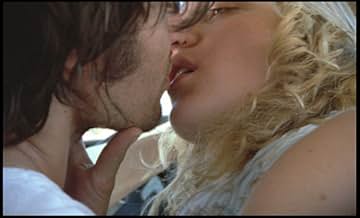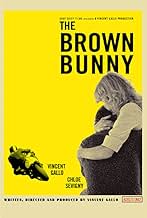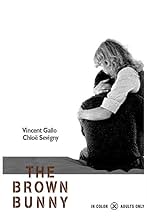Professional motorcycle racer Bud Clay heads from New Hampshire to California to race again. Along the way he meets various needy women who provide him with the cure to his own loneliness, b... Read allProfessional motorcycle racer Bud Clay heads from New Hampshire to California to race again. Along the way he meets various needy women who provide him with the cure to his own loneliness, but only a certain woman from his past will truly satisfy him.Professional motorcycle racer Bud Clay heads from New Hampshire to California to race again. Along the way he meets various needy women who provide him with the cure to his own loneliness, but only a certain woman from his past will truly satisfy him.
- Awards
- 1 win & 6 nominations total
- Director
- Writer
- All cast & crew
- Production, box office & more at IMDbPro
Featured reviews
While I give the film kudos for a story that I didn't see coming, after the first few minutes of needless (and extremely boring) motorcycle racing, I could see that I was NOT in the hands of a professional editor. The story could have been told far more effectively in half the time--or less. Gallo definitely needed to step away and let a professional editor do his/her thing and mercilessly cut scenes that didn't move the story forward.
While I could see that the author wanted the audience to crawl inside the protagonist, Bud, during the road trip, it didn't take that darned long to do it. Plus, his point of view changed too frequently. If we are inside his skin, then why are we looking at him for minutes in an excruciatingly long and tedious long shot? We need to see what he sees--at least with more consistency. I couldn't get my bearings in terms of what I was supposed to be experiencing and from what viewpoint.
There were other technical problems such as an inconsistency in lighting and shot quality with no apparent reason. And that spotted windshield drove me nuts. If a sign of depression and the carelessness that results from it, I'd have appreciated technique that didn't interfere so much with the visuals. Speaking of visuals, extending driving sequences to cover a song also seemed visually uninspired.
Probably most important, Gallo ignored common expectations of audiences and wanted things his way. I can't believe there wasn't an acceptable compromise. I'm pretty patient when it comes to art and film as art, but don't appreciate my sensibilities and expectations to be pushed beyond the breaking point when there appears to be no artistic justification for it. Too many scenes suffered from too few cuts and ran far too long, engendering more audience frustration than heightened emotionalism. I think this may be a result of an inexperienced and slightly self-indulgent filmmaker.
These technical problems aside, I'm usually able to spot a twist a mile away--but not this time. I wondered why all the women he encountered had flower names but that was just a hint that didn't make much sense until the end. But his name? Bud, as in "flower bud" and "clay" as in a substance in which flowers grow (he couldn't have named the character "dirt" or "mulch," after all) might have been a bit over the top. Again, typical of an immature filmmaker.
Was the encountered women's immediate sexual response to a complete stranger, fantasy on the character's part or the filmmaker's? I'd like to know how many men run into so many compliant females. From what I hear, not many--even when the guy is young, good-looking, and clearly pitiable. In this day and age, we ladies are a bit more cautious than that. Sorry, Vincent. While this may have been believable for males, I don't expect it was for very many female viewers.
I watched the film largely because I wanted to see if and how graphic sex could be incorporated into a drama without lowering it to the level of "high brow pornography." I think the film did a good job on that score, although I'd have preferred the use of a realistic-looking prosthetic such as that used in Boogie Nights. Perhaps the budget didn't allow for it or...who knows? It was certainly an interesting artistic choice and one that leaves me scratching my head in terms of the motive for including it. Symbolically, I'm a bit confused about it.
As effective and surprising as the end twist was, there could have been more in terms of Bud's descent into depression. But then, I'm a psychologist so am aware that symptoms are more than seeking surrogates, crying, and looking forlorn and depressed. Gallo missed, IMO, a chance to show more about what guilt and loss look like and how they affect people. Perhaps, this again, is a result of his inexperience. Personally, I think Redford's "Ordinary People" did a better job of showing a wider breadth of feelings of grief and loss.
Bottom line, although I thought the story had merit and did an excellent job of building to a surprising twist, I think it suffered severely in the journey towards the denouement. I hope Gallo matures and grows as a storyteller and filmmaker as I think he's got something to say worth watching.
While I could see that the author wanted the audience to crawl inside the protagonist, Bud, during the road trip, it didn't take that darned long to do it. Plus, his point of view changed too frequently. If we are inside his skin, then why are we looking at him for minutes in an excruciatingly long and tedious long shot? We need to see what he sees--at least with more consistency. I couldn't get my bearings in terms of what I was supposed to be experiencing and from what viewpoint.
There were other technical problems such as an inconsistency in lighting and shot quality with no apparent reason. And that spotted windshield drove me nuts. If a sign of depression and the carelessness that results from it, I'd have appreciated technique that didn't interfere so much with the visuals. Speaking of visuals, extending driving sequences to cover a song also seemed visually uninspired.
Probably most important, Gallo ignored common expectations of audiences and wanted things his way. I can't believe there wasn't an acceptable compromise. I'm pretty patient when it comes to art and film as art, but don't appreciate my sensibilities and expectations to be pushed beyond the breaking point when there appears to be no artistic justification for it. Too many scenes suffered from too few cuts and ran far too long, engendering more audience frustration than heightened emotionalism. I think this may be a result of an inexperienced and slightly self-indulgent filmmaker.
These technical problems aside, I'm usually able to spot a twist a mile away--but not this time. I wondered why all the women he encountered had flower names but that was just a hint that didn't make much sense until the end. But his name? Bud, as in "flower bud" and "clay" as in a substance in which flowers grow (he couldn't have named the character "dirt" or "mulch," after all) might have been a bit over the top. Again, typical of an immature filmmaker.
Was the encountered women's immediate sexual response to a complete stranger, fantasy on the character's part or the filmmaker's? I'd like to know how many men run into so many compliant females. From what I hear, not many--even when the guy is young, good-looking, and clearly pitiable. In this day and age, we ladies are a bit more cautious than that. Sorry, Vincent. While this may have been believable for males, I don't expect it was for very many female viewers.
I watched the film largely because I wanted to see if and how graphic sex could be incorporated into a drama without lowering it to the level of "high brow pornography." I think the film did a good job on that score, although I'd have preferred the use of a realistic-looking prosthetic such as that used in Boogie Nights. Perhaps the budget didn't allow for it or...who knows? It was certainly an interesting artistic choice and one that leaves me scratching my head in terms of the motive for including it. Symbolically, I'm a bit confused about it.
As effective and surprising as the end twist was, there could have been more in terms of Bud's descent into depression. But then, I'm a psychologist so am aware that symptoms are more than seeking surrogates, crying, and looking forlorn and depressed. Gallo missed, IMO, a chance to show more about what guilt and loss look like and how they affect people. Perhaps, this again, is a result of his inexperience. Personally, I think Redford's "Ordinary People" did a better job of showing a wider breadth of feelings of grief and loss.
Bottom line, although I thought the story had merit and did an excellent job of building to a surprising twist, I think it suffered severely in the journey towards the denouement. I hope Gallo matures and grows as a storyteller and filmmaker as I think he's got something to say worth watching.
If you can endure a 90 minute portrait of brooding self loathing with virtually no dialog and uninspired cinematography, this film is for you. The notorious scene with Daisy is incongruous. Perhaps, I am dense, but in my view, the emperor has no clothes. To be successful, this film should have elicited a strong interest in the lead character. But in the end, you have learned little about someone who is shallow and unappealing. This film portrays the journey of a motorcyclist tormented by demons vaguely hinted at in mysterious stops he makes in route. You see that he is attracted and repulsed by women. (Cheryl Tiegs, for those of you old enough to remember her from the 1970s is perfect in what amounts to a cameo.) But his encounters with women are so fleeting and glancing that you learn little until the end of the journey. Then, what you learn is too trite to support your having endured the trip with him. I believe Vincent Gallo had a serious idea, but the idea is unrealized.
Brown Bunny, The (2004)
BOMB (out of 4)
Vincent Gallo's controversial film was one that I was really looking forward to but at the two minute mark of the film I really wanted to turn it off. This is the type of film that should have been a home movie about a depressed maniac being alone and that's that. Instead Gallo tries to do an art picture but it doesn't work at all, although I certainly wouldn't call this one of the worst films ever made. As much as I hate to say it but it's clear by watching this bomb that the guy does have some talent and I think some of this talent shines through here but in the end the film rubbed me the wrong way and never got me involved in the story. I was annoyed by Gallo's character and really didn't care what was going to happen to him. It was also quite annoying because it seems Gallo is begging the audience to care and love him yet he doesn't give us a reason to do so. I can certainly understand how some would fall into the film but that didn't happen with me. I would be interested in seeing the Cannes cut to learn how Roger Ebert went from a BOMB to a three star rating.
BOMB (out of 4)
Vincent Gallo's controversial film was one that I was really looking forward to but at the two minute mark of the film I really wanted to turn it off. This is the type of film that should have been a home movie about a depressed maniac being alone and that's that. Instead Gallo tries to do an art picture but it doesn't work at all, although I certainly wouldn't call this one of the worst films ever made. As much as I hate to say it but it's clear by watching this bomb that the guy does have some talent and I think some of this talent shines through here but in the end the film rubbed me the wrong way and never got me involved in the story. I was annoyed by Gallo's character and really didn't care what was going to happen to him. It was also quite annoying because it seems Gallo is begging the audience to care and love him yet he doesn't give us a reason to do so. I can certainly understand how some would fall into the film but that didn't happen with me. I would be interested in seeing the Cannes cut to learn how Roger Ebert went from a BOMB to a three star rating.
Okay, "The Brown Bunny" is a 7 minute movie that is dragged on for 93 painful minutes. How does this happen? Well, it's pretty clear to me that Vincent Gallo really likes the look of his own stubbly face from really close up. I came to this conclusion when I realized it accounts for about twenty to twenty-five minutes of the movie. Then you add in that Vincent Gallo owns a very nice motorcycle...that he likes to show off. The motorcycle doesn't actually take up to much of the screen time (unfortunately), but it does allow some kind of premise. What really bugs me is that there are people who think that this movie was deep. It's not, I can see how the basic premise could be turned into something deep and artistic. But a bad motorcycle driver who has a thing for chics named after flowers and imagines his dead drug addict girlfriend giving him head is not deep by itself, and it doesn't help just to have long scenes of traffic and a not very attractive stubbly mans face. The only reason this movie has gotten any recognition whatsoever is the shock value of showing a blowjob in a non-skin flick. So once again, WTF?
After racing in New Hampshire, the lonely motorcycle racer Bud Clay (Vincent Gallo) drives his van in a five-day journey to California for the next race. Along his trip, he meets fan, lonely women, prostitutes, but he leaves them since he is actually looking for the woman he loves, Daisy (Chloë Sevigny). He goes to her house and leaves a note telling where he is lodged. Out of the blue, Daisy appears in his hotel room and soon he learns why he cannot find her.
"The Brown Bunny" is an independent very low budget movie by Vincent Gallo. The plot is developed in slow pace and is dull and boring in many moments. The revelation of Daisy's secret is totally unexpected. However the movie has become famous only because of the unnecessary fellatio of Chloë Sevigny, maybe to satisfy Vincent Gallo's ego, since does not add anything but a polemic scene to this movie in a poor hype. My vote is five.
Title (Brazil): Not available on DVD or Blu-Ray
"The Brown Bunny" is an independent very low budget movie by Vincent Gallo. The plot is developed in slow pace and is dull and boring in many moments. The revelation of Daisy's secret is totally unexpected. However the movie has become famous only because of the unnecessary fellatio of Chloë Sevigny, maybe to satisfy Vincent Gallo's ego, since does not add anything but a polemic scene to this movie in a poor hype. My vote is five.
Title (Brazil): Not available on DVD or Blu-Ray
Did you know
- TriviaRoger Ebert called the film "the worst in the history of Cannes." He posted on his website "The audience was loud and scornful in its dislike for the movie; hundreds walked out, and many of those who remained only stayed because they wanted to boo." Vincent Gallo responded that Ebert was a "fat pig with the physique of a slave trader." Ebert paraphrased a remark of Sir Winston Churchill and responded that "Although I am fat, one day I will be thin, but Mr. Gallo will still have been the director of 'The Brown Bunny.'" Gallo then put a hex on Ebert's colon, to which Ebert responded that "even my colonoscopy was more entertaining than his film." (It should be noted that the version screened at Cannes was much longer than the final version.)
- GoofsWhen Bud speaks to Daisy's mother, a glass on the table appears and then disappears between shots.
- Alternate versionsSince its world premiere at Cannes the movie has been re-edited although the sex scenes remain intact. The version that premiered theatrically in the US is 26 minutes shorter than the Cannes cut.
- How long is The Brown Bunny?Powered by Alexa
Details
Box office
- Budget
- $100,000 (estimated)
- Gross US & Canada
- $366,301
- Opening weekend US & Canada
- $50,601
- Aug 29, 2004
- Gross worldwide
- $402,599
- Runtime1 hour 33 minutes
- Color
- Sound mix
- Aspect ratio
- 1.66 : 1
Contribute to this page
Suggest an edit or add missing content



























